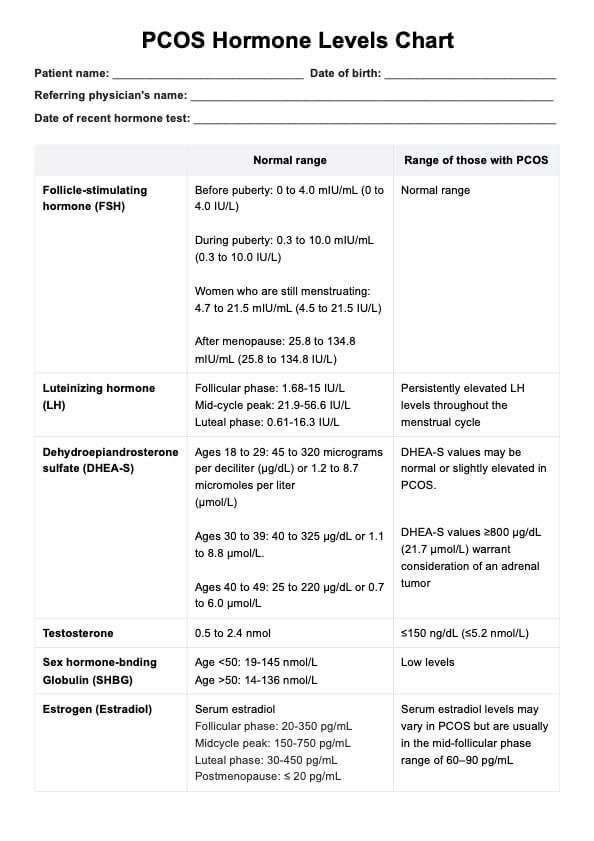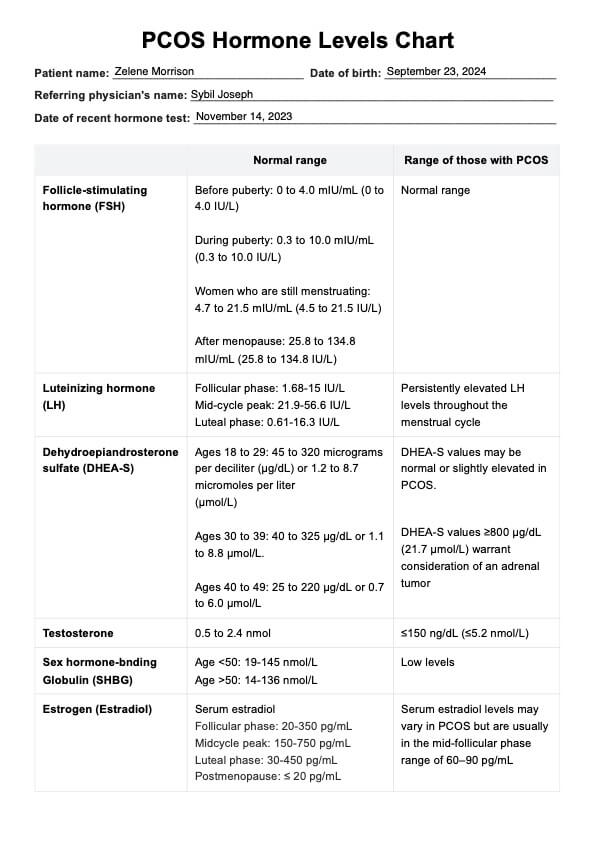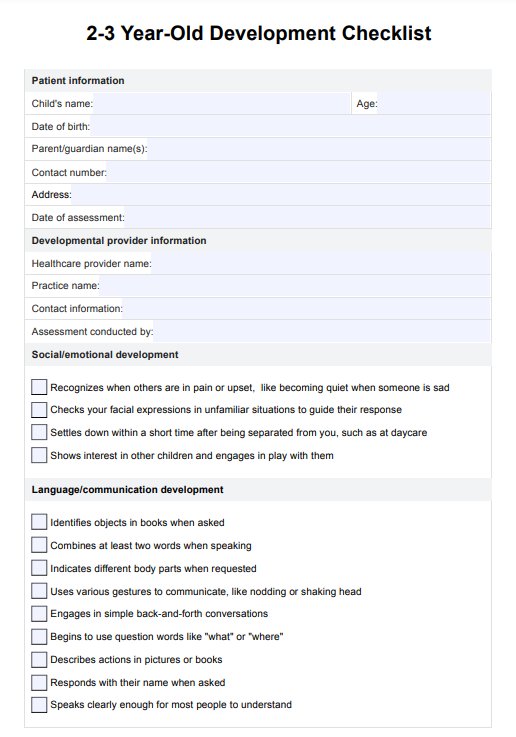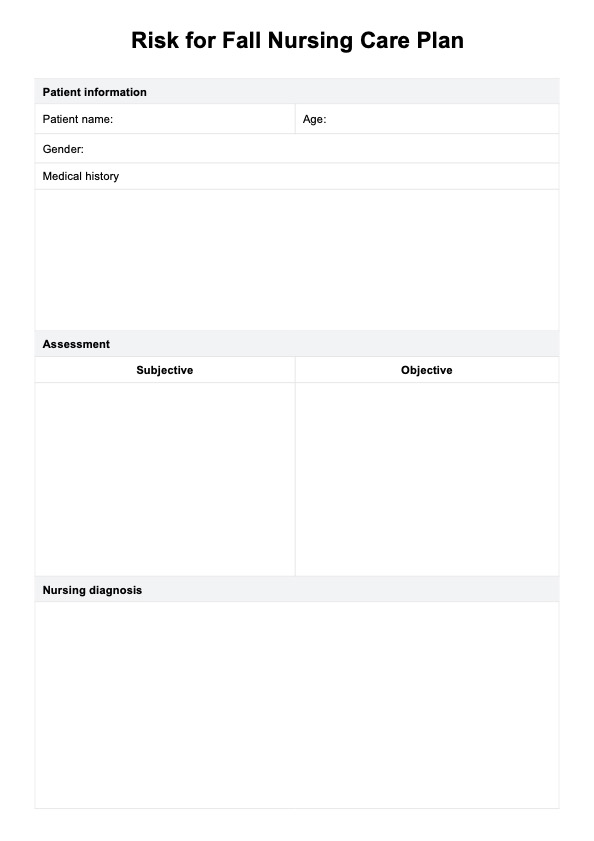PCOS Hormone Levels Chart
Ensure that you have a PCOS Hormone Levels Chart on hand when analyzing your patient’s results to determine if they have PCOS or another underlying condition.


What is a PCOS Hormone Levels Chart?
Polycystic ovarian syndrome (PCOS) is an endocrine disorder commonly affecting reproductive-aged women that is characterized by a variety of symptoms. PCOS symptoms include the likes of excessive androgen (male hormones) levels, excess hair growth, irregular menstrual periods, and the formation of small cysts on the ovaries due to the pituitary gland becoming overactive. Patients with polycystic ovaries have an increased risk of having high blood pressure and insulin resistance, too.
A PCOS Hormone Levels Chart is a valuable tool used by healthcare practitioners in the diagnosis, assessment, monitoring, and management of PCOS. The chart provides information on measurements of key hormones typically associated with PCOS, such as the following:
- Follicle-stimulating hormone (FSH)
- Luteinizing hormone (LH)
- Testosterone
- Estrogen
- Anti-Müllerian hormone (AMH)
- Sex hormone-binding globulin (SHBG)
- Dehydroepiandrosterone sulfate (DHEA-S)
- Other hormones tested to diagnose PCOS like thyroid stimulating hormone (TSH)and androstenedione.
Since there isn't a standard PCOS Hormone Levels Chart, you may notice that the hormones included in charts may vary. Generally, said resources provide information on those in the list above. On our take of the chart, you can expect a list of the hormones related to PCOS and their normal ranges, ranges expected in a patient with PCOS, and sections for patient details and interpretation.
PCOS Hormone Levels Chart Template
PCOS Hormone Levels Chart Example
How does it work?
Here's how to incorporate our PCOS Hormone Levels Chart into your practice:
Step 1: Procure a printable PCOS Hormone Levels Chart
To ensure prompt access to this invaluable resource, click either the "Download Template" or "Use Template" button. Alternatively, you can find the "PCOS Hormone Levels Chart" within the Carepatron template library, which is accessible through the app or website.
Step 2: Input essential patient information
If your intent goes beyond using the chart merely as a reference for patient education on PCOS hormone levels, it is advisable to complete critical patient details.
Step 3: Compare and analyze
Subsequently, you can use the chart to compare the normal reference hormone levels and the patient's specific hormonal values. It is essential to consider additional factors during your assessment, such as the patient's age, medical history, and symptoms.
Step 4: Document interpretations
Our template has a designated area for recording your observations and findings. This space can also be used to include any supplementary notes, information about necessary medical interventions, or recommendations for further diagnostic examinations.
Step 5: Securely store the template
Upon concluding your evaluation, it is crucial to securely store the template, ensuring that access is limited to authorized individuals only. We recommend using Carepatron, a HIPAA-compliant, free patient records software for digital copies. This platform offers robust security for all medical records, including completed PCOS Hormone Levels Charts.
When would you use this chart?
The PCOS Hormone Levels Chart is a valuable tool that practitioners can apply during the various aspects of the diagnosis and management process of Polycystic Ovary Syndrome (PCOS). Here are several scenarios when it is used:
Diagnosis of PCOS
The PCOS Hormone Levels Chart is primarily utilized in the initial diagnosis of PCOS. When a patient presents with symptoms suggestive of PCOS, healthcare providers may conduct blood tests that measure hormones. These tests, along with others, rule out other conditions with similar symptoms and provide an overview of hormonal imbalances.
Understanding hormone levels
Beyond diagnosis, the PCOS Hormone Levels Chart is an educational resource for patients. It allows individuals to better understand their condition by visualizing their hormone profiles. This understanding empowers patients to advocate for themselves and better cope with the distressing symptoms and side effects associated with PCOS.
Monitoring treatment
For those undergoing treatment for PCOS, the hormone levels chart plays a crucial role in tracking the response to therapeutic interventions. It enables healthcare providers to assess the effectiveness of the treatment and make necessary adjustments based on the evolving hormonal patterns. Regular monitoring with the chart ensures that the chosen treatment strategies are tailored to each patient's unique hormonal profile, optimizing the management of PCOS.
Managing irregular menstrual periods and androgen excess
Another important application of the PCOS Hormone Levels Chart is managing irregular menstrual periods and symptoms of androgen excess, such as acne and excessive hair growth. Androgens, or male hormones, are often elevated in individuals with PCOS, leading to irregular periods or even a complete absence of the menstrual cycle. The chart allows healthcare providers to observe how hormone levels deviate from those in a normal menstrual cycle, guiding treatment decisions aimed at reducing androgens and restoring more regular menstrual cycles. Monitoring these levels is essential for balancing reproductive hormones and improving overall health.
Commonly asked questions
Gynecologists, endocrinologists, and PCOS specialists are the healthcare practitioners who typically request a PCOS Hormone Levels Chart.
PCOS hormone level charts are primarily used to diagnose PCOS, monitor its treatment, understand the patient's hormone levels, and finally evaluate their menstrual cycle.
The PCOS Hormone Levels Charts can be used as a reference, guide, and educational resource to teach the patient more about their hormones and possible PCOS diagnosis. Additionally, it can be used to indicate the overall results of all the testing a patient has undergone to determine if they have PCOS or not.
















































































































